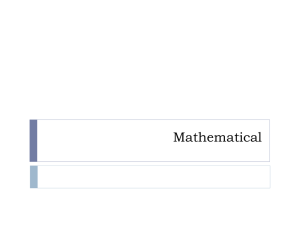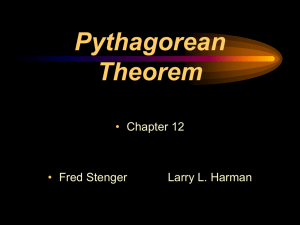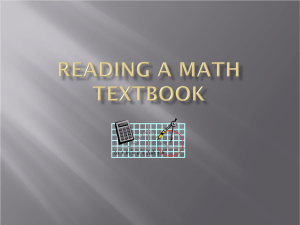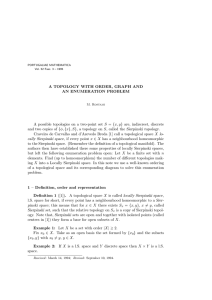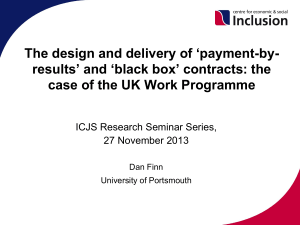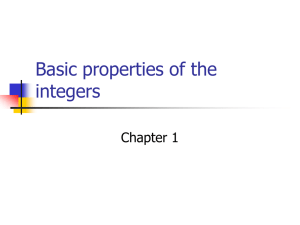Prime Numbers and How to Avoid Them
advertisement
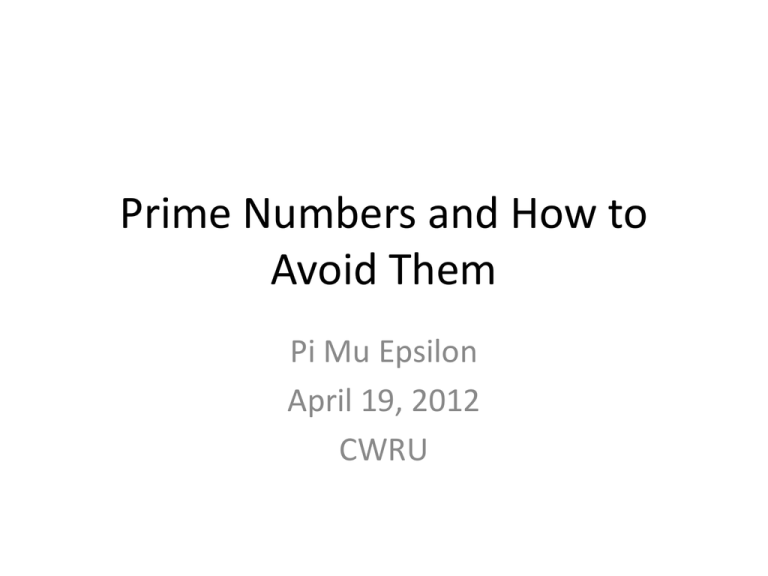
Prime Numbers and How to
Avoid Them
Pi Mu Epsilon
April 19, 2012
CWRU
Sequences including primes
• 1, 2, 3, 4, 5, 6, 7, 8, 9, 10, 11, 12, 13, 14, …
• 2, 3, 5, 7, 11, 13, 17, 19, 23, 29, 31, 37,…
• 3, 5, 7, 9, 11, 13, 15, 17, 19, 21, 23, 25, …
Avoiding Primes
• 2, 4, 6, 8, 10, 12, 14, 16, 18, 20, 22, 24,…
That almost works. If we start with a non-prime,
we can avoid primes entirely:
4, 8, 12, 16, 20, 24, 28, 32, 36, 40, 44, 48, …
But these numbers are all divisible by a common
factor. That’s too easy.
Arithmetic sequences
• Suppose we look only at sequences of the
form {An+B} , Where A and B have no
common factor.
• 199, 409, 619, 829,1039, 1249, 1459, 1669,
1879,2089, 2299, 2509, 2719, 2929, …
This was discovered by Edward Escott in 1910.
Green and Tao (2004) have proved that k
consecutive primes occur in some arithmetic
sequence, for any k.
But we want ONLY primes
• Then by the prime number theorem
arithmetic progressions will not work. Let’s try
exponentially growing lists.
• Numbers one less than a power of 2:
• 1,3,7,15,31,63,127,255,511,1023,2047,4095,
8191, 16383, 32767,65535, 131071,262143,
524287, 1048575,…
Mersenne
Add one instead
Finally getting somewhere?
Fermat Numbers
• 3, 5, 17, 257, 65537, 4294967297,
18446744073709551617,
340282366920938463463374607431768211457,
…
Nice try, Pierre!
What went wrong?
The order of 2
• So Euler saw he only had to test divide by
65, 129, 193, 257, …, 64k+1
In fact, he only needed to divide by primes in
this list. When k=10 it works.
Looking for Fermat Primes
• By generalizing this argument, it can be seen
that testing for Fermat primes requires looking
at prime numbers of the form
A New Question
Sierpinski’s Theorem (1960)
Proof of Sierpinski’s Theorem
1 2 3 4 5 6 7 8 9 10 11 12 13 14 15 16
17 18 19 20 21 22 23 24 25 26 27 28 29 30 31 32
33 34 35 36 37 38 39 40 41 42 43 44 45 46 47 48
49 50 51 52 53 54 55 56 57 58 59 60 61 62 63 64
The integers can be divided into seven sets:
2n, 4n+1, 8n+3, 16n+7, 32n+31, 64n+15, 64n+47
Proof of Sierpinski’s Theorem
Now the plan is to divide the exponents into
those seven groups, and for each group find a
prime that always divides numbers whose
exponents belong to that group.
Proof of Sierpinski’s Theorem
So when k is any number of the form 3i+2, half
the terms in the sequence will be divisible by
3.
Proof of Sierpinski’s Theorem
Example: k=5 n=1,2,3,…
11, 21, 41, 81, 161, 321, 641, 1281, 2561, 5121,…
So when k is any number of the form
5i+2, a quarter of the terms in the
sequence will be divisible by 5.
Proof of Sierpinski’s Theorem
When k=17, these happen at the same time:
35, 69, 137, 273, 545, 1089, 2177, 4353,
8705,17409, 34817, 69633, 139265, 278529,
557057, 1114113, 2228225, 4456449,…
Three quarters of the terms are divisible by 3 or
5, but occasionally a prime keeps showing up.
Proof of Sierpinski’s Theorem
Proof of Sierpinski’s Theorem
Proof of Sierpinski’s Theorem
Proof of Sierpinski’s Theorem
Proof Concluded
The “Chinese Remainder Theorem” guarantees
we can find infinitely many such numbers. The
smallest is
k= 201 44650 31451 65117
This is a “Sierpinski number”, which makes every
term in the infinite sequence composite. Half
are divisible by 3, a quarter divisible by 5, etc.
What is the smallest Sierpinski
number?
• In 1962, John Selfridge found the number
78577 (= 17 x 4621). It is conjectured that this
is the smallest such number.
• To rule out a smaller value of k it is necessary
to find a prime number for some n and this k.
• As of March 2002 there were only 17 smaller
values for which no prime had been found.
Seventeen or Bust
• The Seventeen or Bust project was started in
2002 by two undergraduates.
• As of October 2007, eleven of the possible
counterexamples were ruled out by finding
primes, the largest of which has almost four
million digits.
• Five of the eleven have been named Stephen
Colbert primes.
This Man Has Your Number
Seventeen or Bust





